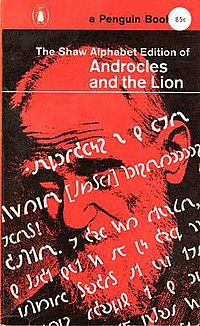
Back Alpabetong Shaviano BCL Shaw-Alphabet German Ŝava alfabeto Esperanto Alfabeto shaviano Spanish Alphabet shavien French शा वर्णमाला Hindi Alfabeto shaviano Italian ショー文字 Japanese Alfabeta de Shaw LFN Aksara Syawi Malay
| Shavian alphabet 𐑖𐑱𐑝𐑾𐑯 𐑨𐑤𐑓𐑩𐑚𐑧𐑑 | |
|---|---|
| Script type | Alphabet
|
| Creator | Ronald Kingsley Read |
Time period | ~1960 to present |
| Direction | Left-to-right |
| Languages | English, Esperanto |
| Related scripts | |
Child systems | Quikscript, Revised Shavian, Ŝava |
| ISO 15924 | |
| ISO 15924 | Shaw (281), Shavian (Shaw) |
| Unicode | |
Unicode alias | Shavian |
| U+10450–U+1047F | |

The Shavian alphabet (/ˈʃeɪviən/ SHAY-vee-ən;[1] also known as the Shaw alphabet) is a constructed alphabet conceived as a way to provide simple, phonemic orthography for the English language to replace the inefficiencies and difficulties of conventional spelling using the Latin alphabet. It was posthumously funded by and named after Irish playwright George Bernard Shaw.
Shaw set three main criteria for the new alphabet. It should be:
- at least 40 letters;
- as phonetic as possible (that is, letters should have a 1:1 correspondence to phonemes);
- distinct from the Latin alphabet to avoid the impression that the new spellings were simply misspellings.
- ^ Wells, John C. (2000). Longman Pronunciation Dictionary. Harlow, England: Pearson Education Ltd.